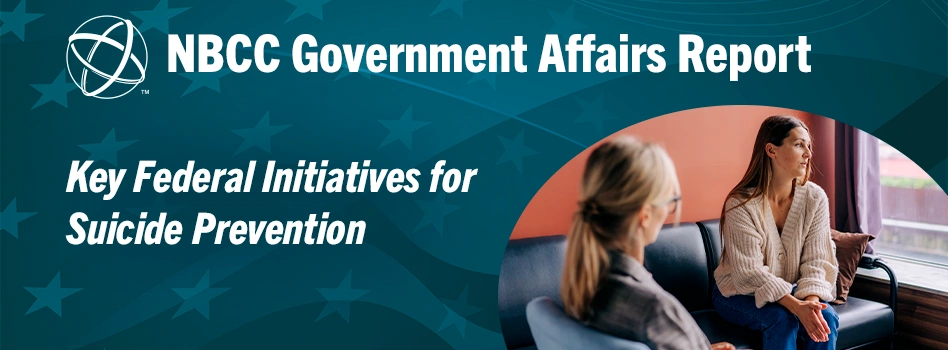- Federal Employment
- Federal Funding
- Indian Health Services
- Medicare
- Military Health Systems
- TRICARE
- Veterans Affairs
Key Federal Initiatives for Suicide Prevention
- Home
- GovtAffairs
- Newsroom
- key-federal-initiatives-for-suicide-prevention
Article Published: 9/30/2024
Over 49,000 Americans lost their lives to suicide in 2022. According to the Centers for Disease Control and Prevention (CDC) an estimated 13.2 million adults seriously thought about suicide, 3.8 million made a plan, and 1.6 million attempted suicide.
Specifically, the National Institute of Mental Health (NIMH) has recently reported that the suicide rate for children 8 to 12 years old has significantly climbed over the past decade, with a substantial rise among young girls. The increase in suicide among America’s youth could be due to several factors, including access to firearms and social media influence. Moreover, according to the research, many had no previously diagnosed mental health condition, suggesting that behavioral health problems may be going untreated.
The federal government, through key agencies responsible for behavioral health issues, implemented several initiatives during the 2021–2024 period to address the uptick in suicides especially due to the COVID-19 pandemic.
Key Initiatives 2021–2023
988 Suicide & Crisis Lifeline is the signature action taken during this period. The Substance Abuse and Mental Health Services Administration (SAMHSA) implemented the free 988 Suicide & Crisis Lifeline hotline.
The 988 number connects the public through various communication platforms such as phone, text, or chat to over 200 state- and local-funded crisis call centers, providing access to crisis counseling, resources, and referrals to mental health providers in the community. During the initial 2 years of its operation, the 988 Lifeline received 10.8 million calls, texts, and chats. In May 2024, monthly contacts across the country exceeded 500,000 communications.
CDC’s Comprehensive Suicide Prevention Program (CSP) funds 24 programs to implement and evaluate a comprehensive public and community-based health approach to suicide prevention. Funding also supports near real-time collection of emergency department data for suicide attempts and suicidal ideation.
CDC’s Suicide Prevention Resource for Action provides strategies with the best available evidence-based practices to reduce suicide. The Prevention Resource was developed to help states and local officials prioritize suicide prevention activities most likely to have an impact.
Vital Signs Report on Firearm Safety, published by the CDC, highlights the growing disparities in gun violence, including gun-related suicide, and emphasizes the importance of lethal means safety and related strategies. The CDC said that “strategies should address the underlying physical, social, economic, and structural conditions known to increase firearm homicide and suicide risks.”
KeepItSecure.net Is a public safety campaign by the Department of Veterans Affairs (VA) to highlight the importance of firearm safe storage in preventing veteran suicide. The VA is working with other organizations to create a joint plan for educating the public on lethal means safety.
Rural Response to Farmer Mental Health and Suicide Prevention by the Health Resources and Services Administration (HRSA) focuses on initiatives to address behavioral health issues, stress, and rising suicide rates among farmers.
Comprehensive Initiatives for 2024
The White House and the Department of Health and Human Services (HHS) have launched the 2024 National Strategy for Suicide Prevention, accompanied by the first-ever Federal Action Plan.
This unprecedented federal initiative, developed in partnership with the Substance Abuse and Mental Health Services Administration (SAMHSA), the Centers for Disease Control and Prevention (CDC), and the National Action Alliance for Suicide Prevention, is a significant step in addressing the growing public health crisis of suicide in the United States.
SAMHSA has created a tool kit that stakeholders can use to get involved.
Congressional Activity 2023–2024
During this session of Congress, policymakers have introduced several suicide prevention policy initiatives.
Former Utah Congressman Chris Stewert and Congresswoman Doris Matsui (D-CA) introduced The Suicide Prevention Act (H.R. 5514), which would establish two grant programs to prevent self-harm and suicide.
Senators Tim Kaine (D-VA) and Brian Schatz (D-HI) introduced The Child Suicide Prevention and Lethal Means Safety Act, which would fund suicide prevention initiatives and ensure health care providers—with an emphasis on primary care physicians—receive training to prevent intentional harm.
Representatives Donald S. Beyer Jr. (D-VA), Brian Fitzpatrick (D-PA), and Grace Napolitano (D-CA) introduced The Barriers to Suicide Act. The legislation would establish a competitive grant program for states and local communities to apply for federal funding to install safety nets and barriers on bridges and make these types of projects eligible under the National Highway Performance Program.
In addition to these legislative efforts discussed, the recently formed bipartisan Senate Mental Health Caucus has stated that one of its key policy priorities is to enhance our nation’s crisis response services and suicide prevention efforts.
NBCC will continue to monitor these initiatives and legislation and let NCCs know of any resulting opportunities for counselors.
Share On Social Media:
Read more articles »
